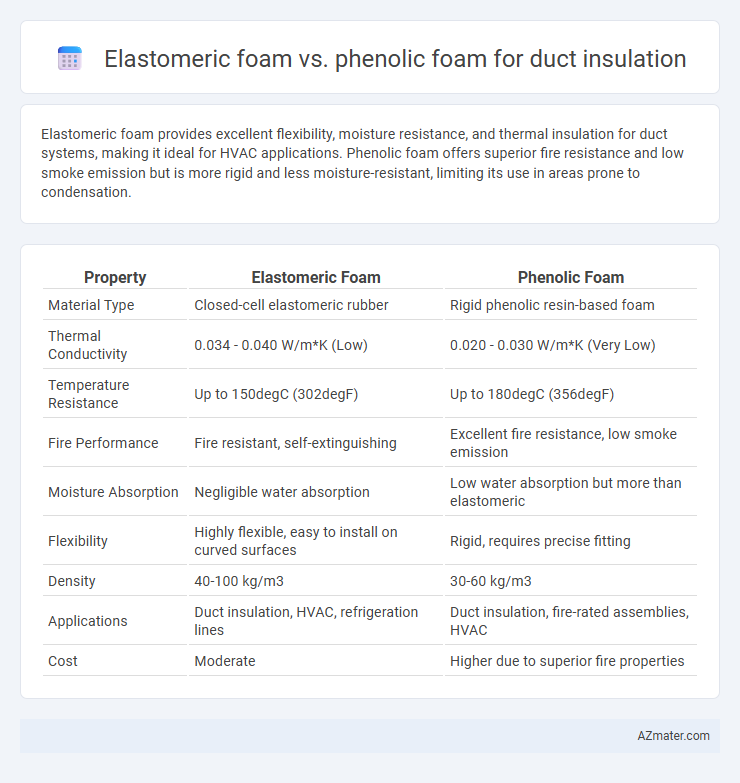Elastomeric foam provides excellent flexibility, moisture resistance, and thermal insulation for duct systems, making it ideal for HVAC applications. Phenolic foam offers superior fire resistance and low smoke emission but is more rigid and less moisture-resistant, limiting its use in areas prone to condensation.
Table of Comparison
| Property | Elastomeric Foam | Phenolic Foam |
|---|---|---|
| Material Type | Closed-cell elastomeric rubber | Rigid phenolic resin-based foam |
| Thermal Conductivity | 0.034 - 0.040 W/m*K (Low) | 0.020 - 0.030 W/m*K (Very Low) |
| Temperature Resistance | Up to 150degC (302degF) | Up to 180degC (356degF) |
| Fire Performance | Fire resistant, self-extinguishing | Excellent fire resistance, low smoke emission |
| Moisture Absorption | Negligible water absorption | Low water absorption but more than elastomeric |
| Flexibility | Highly flexible, easy to install on curved surfaces | Rigid, requires precise fitting |
| Density | 40-100 kg/m3 | 30-60 kg/m3 |
| Applications | Duct insulation, HVAC, refrigeration lines | Duct insulation, fire-rated assemblies, HVAC |
| Cost | Moderate | Higher due to superior fire properties |
Introduction to Duct Insulation Materials
Elastomeric foam and phenolic foam are prominent materials used in duct insulation, each offering distinct thermal and acoustic properties. Elastomeric foam provides excellent flexibility, moisture resistance, and thermal performance, making it ideal for HVAC systems in humid environments. Phenolic foam excels in fire resistance and low smoke emission, offering superior thermal insulation with a rigid structure suited for demanding industrial applications.
What is Elastomeric Foam?
Elastomeric foam is a flexible, closed-cell insulation material composed primarily of synthetic rubber, offering superior thermal performance and moisture resistance, making it ideal for duct insulation in HVAC systems. It provides excellent sound absorption and durability, preventing condensation and reducing energy loss in ducts operating between -40degC and 110degC. Compared to phenolic foam, elastomeric foam is more resistant to cracking and easier to install on curved or irregular duct surfaces.
What is Phenolic Foam?
Phenolic foam is a rigid, closed-cell insulation material known for its excellent fire resistance, low smoke emission, and thermal performance, making it ideal for duct insulation. It has a high R-value per inch and superior dimensional stability compared to elastomeric foam, which is flexible but less fire-resistant. Phenolic foam's low thermal conductivity and resistance to moisture absorption help maintain indoor air quality and energy efficiency in HVAC systems.
Thermal Performance: Elastomeric vs Phenolic Foam
Elastomeric foam offers superior thermal performance for duct insulation with low thermal conductivity values typically around 0.034 to 0.040 W/m*K, providing excellent heat resistance and preventing condensation. Phenolic foam, although having slightly higher thermal conductivity values ranging from 0.038 to 0.045 W/m*K, delivers effective thermal insulation with enhanced fire resistance and dimension stability. Elastomeric foam's closed-cell structure contributes to its low moisture absorption, making it more efficient in maintaining consistent thermal performance in humid environments compared to phenolic foam.
Fire Resistance and Safety Comparison
Elastomeric foam offers superior flexibility and excellent thermal insulation but has moderate fire resistance with low smoke toxicity, making it safer for occupant exposure in duct insulation applications. Phenolic foam provides exceptional fire resistance with a high Limiting Oxygen Index (LOI) above 30%, low flame spread, and minimal smoke production, enhancing overall fire safety in HVAC systems. Choosing between elastomeric and phenolic foam depends on balancing flexibility needs with stringent fire safety regulations and smoke emission standards.
Moisture and Vapor Resistance
Elastomeric foam offers superior moisture resistance with a closed-cell structure that effectively prevents water absorption and minimizes vapor permeability, ensuring long-term duct insulation performance. Phenolic foam, while providing high thermal insulation, has a more brittle structure that can be susceptible to moisture ingress and vapor diffusion over time, potentially compromising insulation integrity. For applications requiring robust moisture and vapor barriers, elastomeric foam is generally preferred due to its resilience and consistent protection against condensation and mold growth.
Installation Process and Flexibility
Elastomeric foam offers superior flexibility and ease of installation for duct insulation due to its closed-cell structure, allowing it to conform easily to irregular shapes and reducing installation time. Phenolic foam is rigid and brittle, requiring precise cutting and careful handling during installation to avoid cracking or breaking, which can increase labor costs. Elastomeric foam also provides seamless sealing around ducts, enhancing thermal efficiency and preventing air leaks more effectively than phenolic foam.
Environmental Impact and Sustainability
Elastomeric foam offers superior environmental benefits with its low Global Warming Potential (GWP) and Zero Ozone Depletion Potential (ODP), making it a sustainable choice for duct insulation. Phenolic foam, while highly effective in thermal insulation, often involves petrochemical-based production with higher embodied carbon and limited recyclability. Selecting elastomeric foam supports reduced carbon footprints and better long-term environmental sustainability in HVAC systems.
Cost Analysis: Elastomeric vs Phenolic Foam
Elastomeric foam generally incurs higher initial costs compared to phenolic foam due to its complex manufacturing process and superior flexibility. Phenolic foam offers a more economical option with lower material and installation expenses, making it favorable for large-scale duct insulation projects. Long-term savings from elastomeric foam arise from its durability and moisture resistance, which can reduce maintenance and replacement costs over time.
Choosing the Right Insulation for Your Ductwork
Elastomeric foam provides superior flexibility, moisture resistance, and thermal insulation, making it ideal for HVAC ductwork in humid environments. Phenolic foam offers high fire resistance and excellent thermal insulation but can be brittle and less flexible, which may pose challenges in complex duct layouts. Selecting the right insulation depends on prioritizing factors such as durability, fire safety standards, and installation complexity for optimal duct performance.

Infographic: Elastomeric foam vs Phenolic foam for Duct insulation
 azmater.com
azmater.com